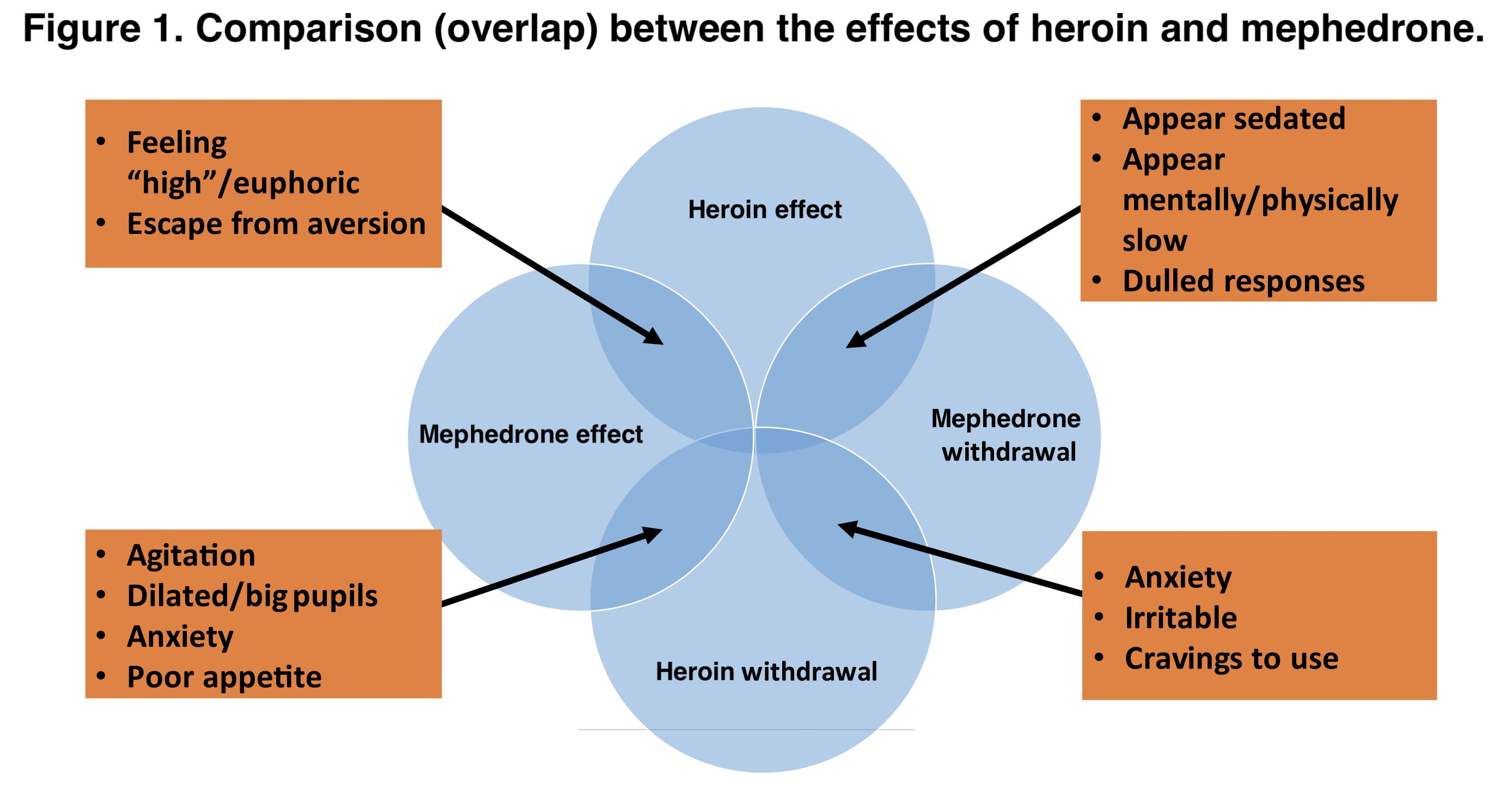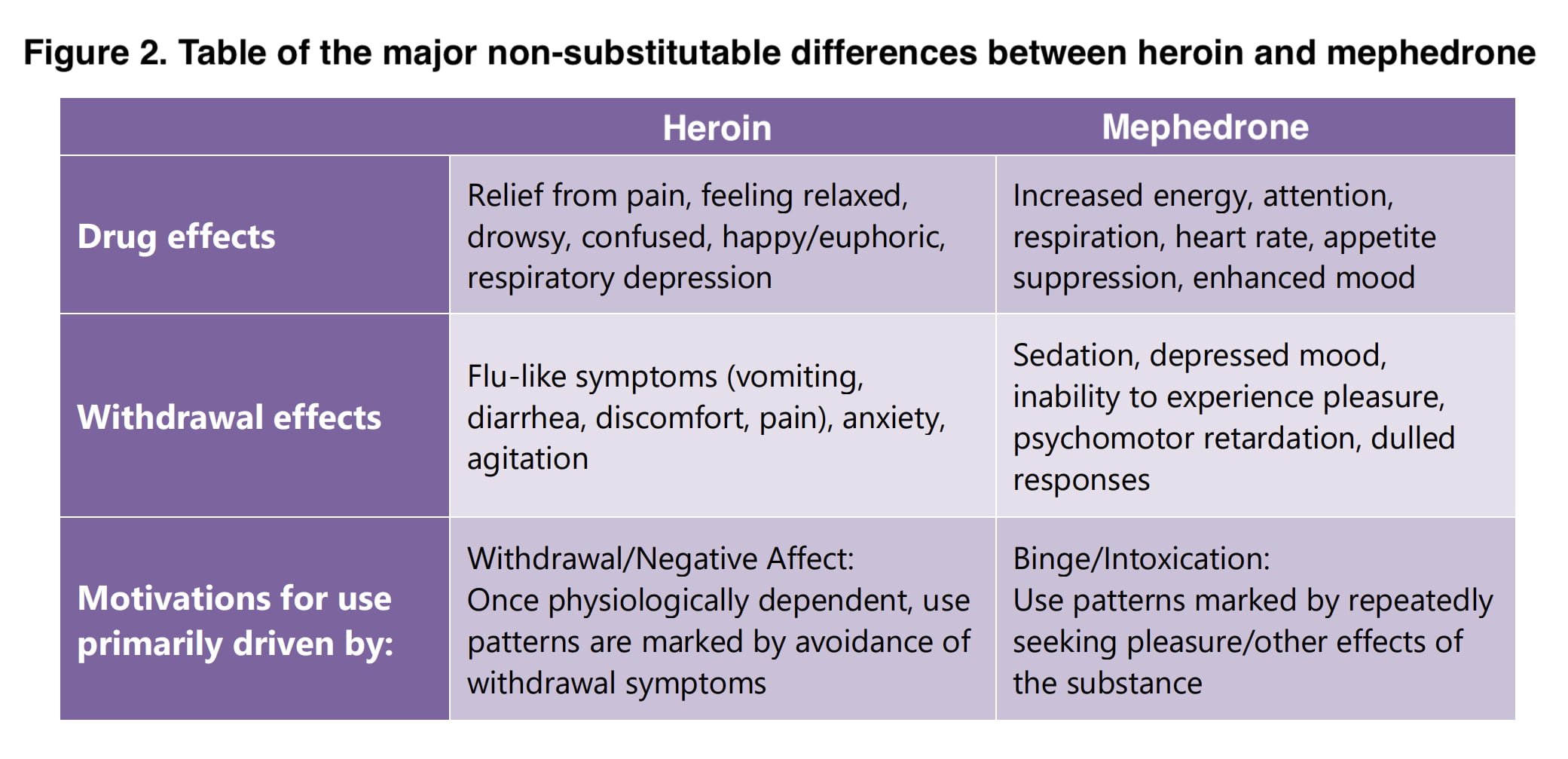Can mephedrone be a substitute for heroin?
Mephedrone instead of heroin: can mephedrone be a substitution therapy for heroin users? Is it dangerous? Why can’t mephedrone and heroin be compared? You will find all the answers to the questions in the text below.
The plant version of mephedrone, extracted from the leaves of the khat plant, has probably been known to man for centuries. In Yemen, for example, these leaves are chewed by almost everyone, young and old. Its effects are much weaker than the synthetic version, but it also leads to hyperactivity, hypertension, depression, stomach upsets, etc.
The synthetic mephedrone was first obtained in 1929 by the French chemist Saem de Burnaga Sanchez. But in those years, no one was particularly interested in the substance, and its recipe got lost. The formula surfaced again only in 2003, in discussions on an Internet forum where “amateur chemists” shared their experiences with the use and manufacture of various drugs.
At that time, mephedrone was synthesized by an Israeli under the nickname Dr. Zee. He tried it on himself, and then decided to start legal production of MCAT, and even succeeded at first. But in 2007 mephedrone got on the list of banned substances in Israel. By that time the formula had become available to most people, and in China and India mephedrone began to be manufactured on an industrial scale.
In Europe, mephedrone spread after 33 tons of safrole (a precursor to MDMA or ecstasy) was intercepted by Interpol in 2008. That’s enough to make a quarter of a billion doses. Left without the most popular club drug, the dealers began to substitute it with a mixture of mephedrone and amphetamine. The end users found this “product” even better and mephedrone flooded Europe.
Soon it was included on all the banned lists. But the problem is that this MCAT is so easy to synthesize that it can literally be made on the spot. The formula is constantly being modified and all kinds of impurities are added to get around the law, make the drug cheaper and speed up the development of addiction.
You have to understand that you can’t get the kind of feelings that you get under the influence of mephedrone from anything else. But it is always pleasure on credit, for which you will have to pay for the rest of your life. Our main “drug dealer” is our brain. When healthy, it rewards us for satisfying important needs: eating, learning new things, getting promoted. It gives us little by little hormones of joy. Mephedrone makes us give out and spend all of it at once. And there is no more left for a normal, ordinary life.
Best mephedrone substitute
Drug substitution (also called displacement or drug substitution) is essentially a conscious switch by a drug user from one drug to another. Substitution can be motivated by several factors, including the drug user’s perception of the higher purity of the drug, the greater availability or lower cost of the substitute drug, or positive expectations in general about the effects of the substitute drug.
The concept of drug substitution is most commonly associated with opioid maintenance therapy, in which a person addicted to opioids (such as heroin) receives a prescribed drug, usually methadone, buprenorphine, or codeine, to minimize the harm associated with opioids. Opioid substitution therapy is a widely accepted harm reduction strategy that is medically justified, relatively safe, and effective. On the other hand, non-medically sanctioned opioid substitution therapy, can be conceptualized as a drug switching model carried out outside the formal treatment setting and initiated by the addict.
User-initiated substitution for heroin and cocaine was documented as early as the first half of the 20th century and has since become a common feature of drug use with the regular emergence of new synthetic drugs that displace or replace old known drugs. Over the past two decades in particular, the substitution phenomenon has gained interest with the emergence of new psychoactive substances, which are often portrayed as “drug substitutes” for known substances.
A number of reasons for substitution behavior have been described. In economic theory, the “substitution effect” refers to the relationship between two goods whose consumption is affected by changes in price, availability, or individual income. For drug markets, substitution effects can explain observed variations in drug consumption patterns as a result of variations in retail drug prices (e.g., cocaine, alcohol, prescription drugs, and heroin).
Such an effect affects drug user preferences. Legal status, price, purity, and availability were among the substitution considerations among a sample of ecstasy and cocaine users who substituted the NPS stimulant for their preferred drug. Users of the synthetic cathinone mephedrone, a functional substitute for methylenedioxymethamphetamine, were not deterred by the substance’s illegal status in the United Kingdom.
Synthetic cathinones are a large group of compounds related to mephedrone, resembling alkaloids with psychoactive properties. The legal status of drugs is not permanent. Every year, dozens of new names of substances with similar effects appear in the illicit traffic. The main producers are China and countries of South-East Asia.
Cheap raw materials are used for the production and the list of precursors is constantly changing. The most dangerous drugs are the following: methylenedioxypyrovalerone (MDPV); alpha-pyrrolidinopentiophenone (α-PVP); methylone; flephedrone. It is almost impossible to visually distinguish the illegal product from other drugs. The laboratory test usually reveals a mixture of several derivatives, less often a single substance. The composition may also include: butylone, pirovalerone, methedrone, methcathinone.
The routes of administration of synthetic cathinones are the same, but the time of action and clinical effects may vary randomly. For mephedrone, attempts have been made to study (in rats) and statistical data are being collected. The pharmacological effects of its relatives are even less well understood. The range of effective dosages is so wide that it is impossible to select a relatively “safe” one.
Using Mephedrone instead of heroin
If you look at the chemical formula of mephedrone, you can see similarities with the amphetamine molecule. The mechanism of action of both substances is based on an abrupt release of neurotransmitters. Due to this, similar motor and hallucinogenic effects are developed. However, the toxicological characteristics of amphetamines are well studied. When “quality” products are consumed, the frequency of symptoms can be predicted.
Clear standards of emergency care in case of overdose have also been developed. Regular intake of amphetamines leads to the formation of severe addiction, critical weight loss, cardiovascular disorders, damage to all internal organs. Drug addicts suffer from chronic and prolonged psychosis and personality disorders. The same outcomes are assumed for mephedrone.
Methylone is the second most popular (and dangerous) synthetic cathinone, which requires a separate consideration. Its clinical effects are between MDMA and mephedrone. It is distinguished by more severe hallucinogenic manifestations and loss of a sense of fear, which causes accidents, traffic accidents and death.
Symptoms of intoxication, as in the case of other poorly studied drugs, are individual. Consequences depend on the dose taken, the methods (and duration) of use, and the state of health. Methylone causes a malignant increase in body temperature (hyperthermia), which quickly leads to death. Other causes of death: acute kidney damage, rhabdomyolysis (massive destruction of muscle tissue), DIC syndrome (combination of thrombosis and bleeding).
Cocaine is a well-studied plant-based drug that has a long history of use. Mephedrone is often perceived as its synthetic analogue. The drugs have a similar principle of action, the methods of use and the clinical picture of intoxication are the same. The differences are in the preservation time of the effects and the long term consequences.
Cocaine use affects the functioning of all tissues. The most vulnerable are the nervous, cardiovascular and respiratory systems. Chronic users suffer from decompensation of internal organs, mental disorders (depression). Complications include ischemia and tissue necrosis of any localization. Abuse leads to cerebral strokes, myocardial infarction, fatal heart rhythm disorders, pulmonary bleeding. Cocaine addiction develops quickly and is difficult to treat. Patients most often apply for help at the stage of multiple organ failure. The first complaints of long-term intoxication are ischemic pain in the heart area, hemoptysis.
Synthetic cathinones, including mephedrone, are virtually unexplored compared to the more “classic” drugs. Their effects are unpredictable and there is no clear understanding of the principle of action. Any ingestion of a product with an unclear composition can be your last. The dangers of amphetamines and cocaine have been proven by years of research.
The substances have a high potential for addiction requiring specialized treatment. Prolonged drug use is accompanied by damage to all organ systems with slight differences. Acute poisoning is often fatal. Thus there are no “safe” analogues of mephedrone. The effect of drugs on a person is individual. Each clinical case has its own peculiarities regardless of the causative substance.
Mephedrone substitute heroine
Heroin and mephedrone are separate classes of substances with different effects. However, these psychoactive substances are related: people who use one may be hooked on the other, one may be substituted for the other, or mask the effects of the other’s withdrawal. Despite the obvious connection between mephedrone and heroin, clinical guidelines and interventions often address only one drug, ignoring the important problem of polyuse.
As different classes of drugs, mephedrone and heroin act differently in the body and cause largely different effects and feelings. People who take heroin are likely to breathe slower, they may feel pain relief, relaxation or drowsiness, confusion, joy or even euphoria.
Although opioids are depressants in the sense that they depress or slow down bodily functions, they have a paradoxical effect on some people, and some people report feeling “energetic” when taking opioids. Mephedrone can also induce feelings of happiness and euphoria. Because MCAT is a “stimulant,” it also makes many people feel energetic and excited, breathing may speed up, and appetite usually decreases. The effects of heroin and mephedrone on the body and brain vary greatly, and in turn, the behavior of the people who use them varies. What drug use (i.e., behavior) looks like varies widely, but here are a few examples:
- A person who has recently used heroin may appear sedated, have difficulty keeping his or her eyes open, appear indifferent, contented, or “out of it.»
- A person taking mephedrone may appear happy or appear agitated; they may exhibit frenetic behavior or express unusual thoughts and behaviors (e.g., seeing or hearing things that others cannot see).
Heroin and mephedrone have fundamentally opposite effects, so it may seem very easy to determine when a person is using one or the other. In practice, the clinical picture can be much more complicated, as there are also similar effects of these psychoactive substances. Figure 1 shows the overlapping effects of heroin and mephedrone.
Another factor that clouds the clinical picture is withdrawal, which occurs when a person’s body adapts to regular drug use and the system “fixes itself” by counteracting the effects of the drug. The effects of withdrawal are the opposite effects of the drug itself, and like the effects of the drug, can look very different when opioids and stimulants are withdrawn. withdrawal of stimulants.
- Heroin withdrawal is usually characterized by acute physical symptoms (vomiting, diarrhea, flu-like) People who take heroin may feel sedated and euphoric, so the effects of withdrawal may mean that the person is agitated, unable to sleep, and experiencing anxiety.
- There are few physical withdrawal symptoms associated with stimulants. Stimulant use can increase energy and pleasure. Consequently, withdrawal may mean that a person experiences fatigue and depressed mood, particularly “anhedonia” (inability to experience pleasure). Extreme sleepiness is both both an effect of withdrawal and a consequence of lack of sleep due to the stimulants.
The combined use of heroin and mephedrone generally does not correspond to two different types of behavior. On the contrary, the use of one may reinforce the use of the other; or in some cases the use of one may replace the use of the other (exceptionally during withdrawal). In private reports or described cases, one can read about the combined use of heroin and mephedrone, as well as cases in which they were interchangeable. Typically, such cases are described by the following criteria:
- The use of both is pleasurable; people say that the simultaneous use of opioids and stimulants has a greater effect than either on its own.
- One drug can intensify the effects of the other. For example, people report that methamphetamine prolongs the effects of opioids by increasing the amount of time before a person goes into opioid withdrawal.
- People can use one drug to lessen the negative effects of another, such as counteracting the sedative effects of opioids by taking stimulants. Or, to avoid feeling “turned on” by stimulants, people may take opioids, especially when a person is weaned off stimulants.
- Drug availability, or lack thereof, can also affect people’s tendency to substitute one drug for another to to counteract or help manage the withdrawal symptoms of another.
- Co-use can be the result of environmental factors. That is, the high availability of both substances in the current environment may predict their use.
Conclusion
As two separate classes of drugs, heroin and mephedrone have different effects on the person who uses them, have different negative and positive consequences, and have slightly different motivations for use. The differences between mephedrone and heroin also mean that their use is supported by different processes and, therefore, mephedrone is not a substitute for heroin.



